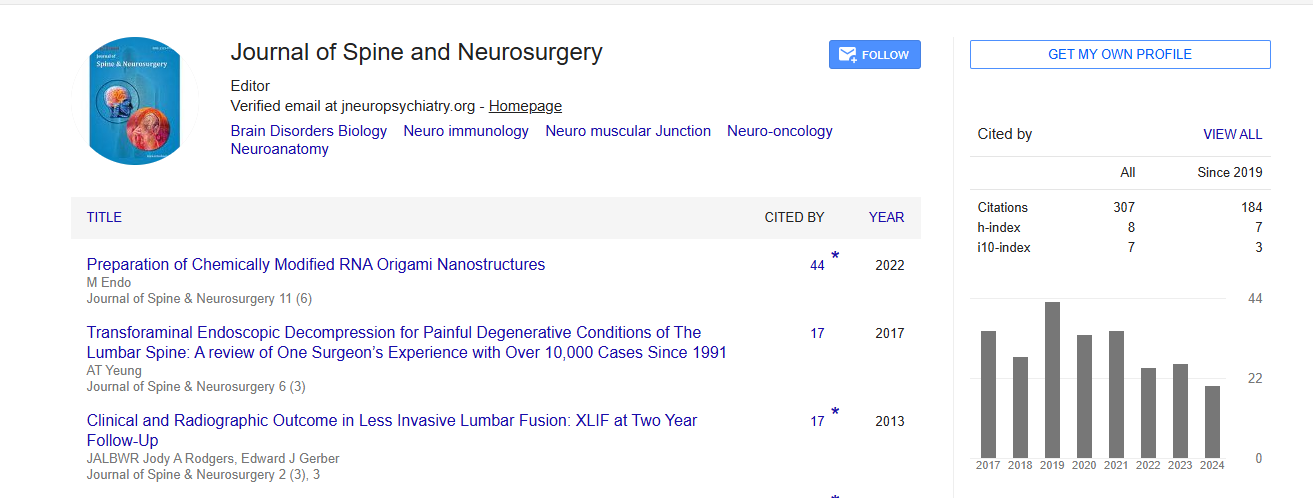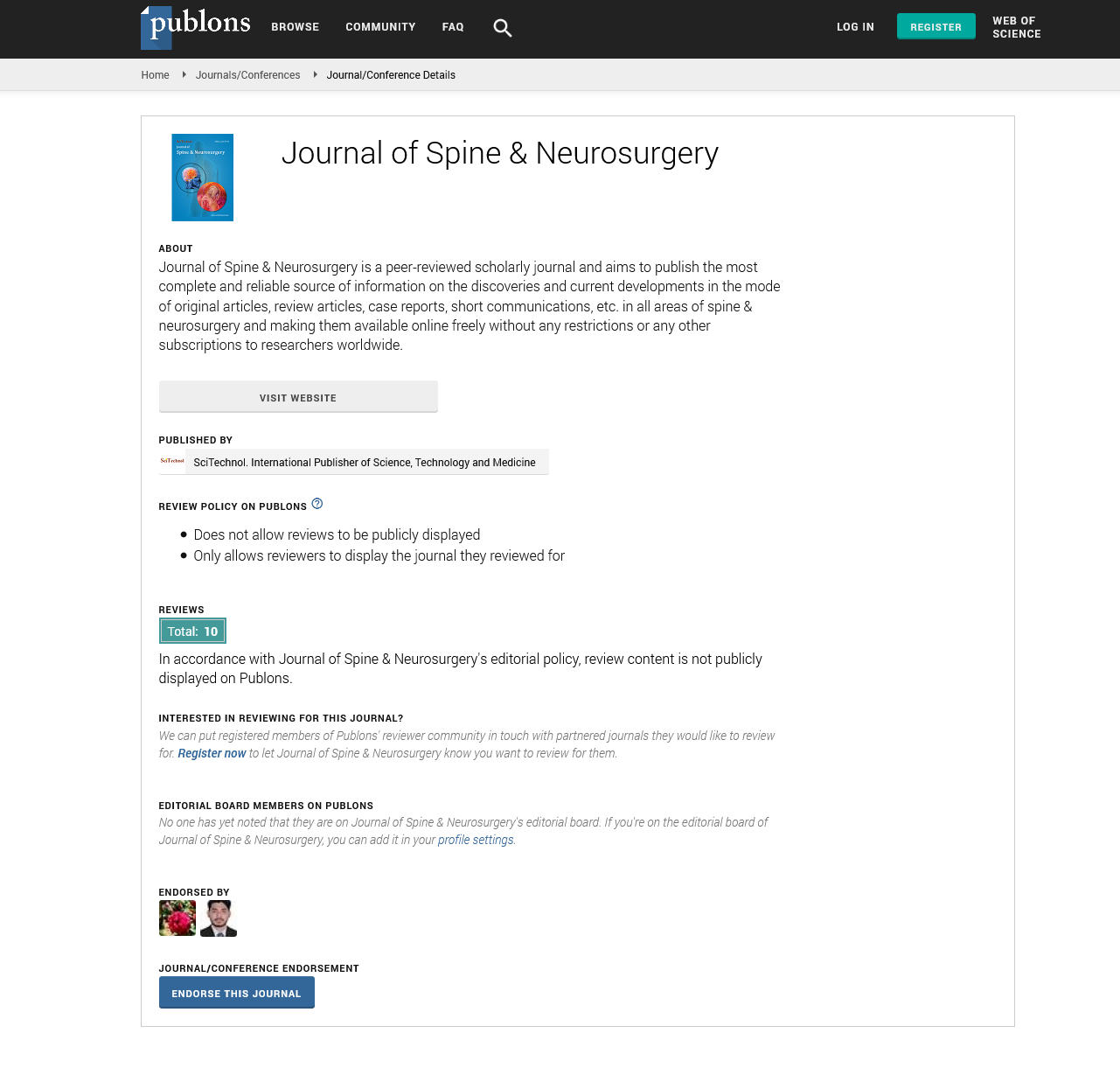Perspective, J Spine Neurosurg Vol: 12 Issue: 6
Exploring the Causes, Symptoms, and Treatments of Herniated Nucleus Pulposus
Phiphi Shi*
1Department of Neurosurgery, University of Texas Health Science Center, San Antonio, Texas
*Corresponding Author: Phiphi Shi,
Department of Neurosurgery, University of
Texas Health Science Center, San Antonio, Texas
E-mail: phi_shi.phi@gmail.com
Received date: 27 November, 2023, Manuscript No. JSNS-24-128409;
Editor assigned date: 29 November, 2023, PreQC No. JSNS-24-128409 (PQ);
Reviewed date: 14 December, 2023, QC No. JSNS-24-128409;
Revised date: 21 December, 2023, Manuscript No. JSNS-24-128409 (R);
Published date: 28 December, 2023, DOI: 10.4172/2325-9701.1000189.
Citation: Shi P (2023) Exploring the Causes, Symptoms, and Treatments of Herniated Nucleus Pulposus. J Spine Neurosurg 12:6.
Description
Herniated Nucleus Pulposus (HNP) commonly referred to as a slipped or ruptured disc, is a prevalent spinal condition that can cause significant pain and discomfort. Understanding the intricacies of HNP, including its causes, symptoms, and available treatments, is essential for individuals grappling with this condition and for those vital to support loved ones affected by it. To comprehend HNP, it is crucial to have a basic understanding of the spine's anatomy. The spine is made up of vertebrae separated by intervertebral discs. These discs consist of a tough outer layer (annulus fibrosus) and a gel-like inner core (nucleus pulposus). The discs act as shock absorbers, providing flexibility and cushioning to the spine.
Causes and symptoms
HNP occurs when the outer layer of an intervertebral disc tears or weakens, allowing the inner nucleus pulposus to protrude or leak out. Several factors contribute to this condition, including age-related degeneration, spinal injuries, improper lifting techniques, and repetitive strain on the spine. Genetics and certain lifestyle factors, such as smoking and obesity, can also increase the risk of developing HNP. Symptoms of HNP can vary based on the location and severity of the herniation. Common signs include localized or radiating pain, numbness, tingling sensations, and muscle weakness. If the herniated disc compresses nearby nerves, it can result in sciatica a sharp, shooting pain that travels down the leg. Additionally, HNP may cause changes in reflexes and muscle function.
Diagnosis and treatment
Diagnosing HNP typically involves a combination of medical history review, physical examination, and diagnostic imaging. Magnetic Resonance Imaging (MRI) is often employed to visualize the spine's structures and identify the location and extent of disc herniation. X-rays and Computed Tomography (CT) scans may also be used to assess spinal alignment and rule out other conditions. The approach to treating HNP depends on the severity of symptoms and the impact on daily life. Conservative treatments may include rest, physical therapy, and pain management through medications. Nonsurgical interventions like epidural steroid injections can provide relief by reducing inflammation around the affected nerve roots. In cases where conservative measures fail to alleviate symptoms, or if there is progressive neurological impairment, surgical options may be considered. Common surgical procedures for HNP include discectomy, laminectomy, or spinal fusion, aimed at decompressing the affected nerve roots and stabilizing the spine. While some factors contributing to HNP are beyond individual control, adopting a healthy lifestyle can help prevent or mitigate the risk of developing this condition. Regular exercise to strengthen the core muscles, maintaining a healthy weight, and practicing proper body mechanics, especially during lifting, can contribute to spinal health.
Conclusion
Herniated Nucleus Pulposus is a common spinal condition that can significantly impact an individual's quality of life. Understanding its causes, recognizing symptoms, and exploring available treatment options empower individuals to make informed decisions about their health. With advancements in medical science and a focus on preventive measures, there is hope for improved management and outcomes for those dealing with the challenges posed by herniated discs. Seeking professional medical advice and adopting a proactive approach to spinal health can pave the way for a more comfortable and active life despite the complexities of HNP. Quitting smoking, which is associated with accelerated disc degeneration, is another beneficial lifestyle change Post-treatment, rehabilitation plays a crucial role in restoring spinal function and preventing future occurrences. Physical therapy and targeted exercises help improve flexibility, strengthen supporting muscles, and promote overall spine health. Following medical advice and adopting a holistic approach to recovery contribute to long-term well-being.
 Spanish
Spanish  Chinese
Chinese  Russian
Russian  German
German  French
French  Japanese
Japanese  Portuguese
Portuguese  Hindi
Hindi 
